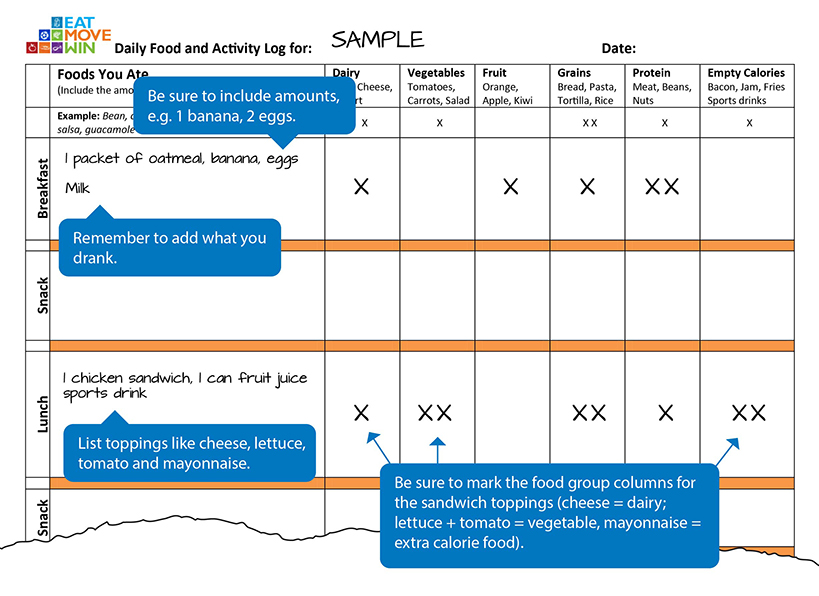Nutrition education designed for high school students. Free Educator Guide to help instructors.

This page as well as Food + You, Food is Fuel and Eating Patterns are designed for high school students and adapted from the online nutrition curriculum Eat Move Win. Teachers are encouraged to add these pages to their Google Classroom and download the free Let’s Eat Healthy Educator’s Guide that provides simple instructions for using these online educational resources.
Vote and then see what others think.

When people get to choose what they want to eat, most choose foods that taste good. Often, little thought is given to the amount of nutrients the foods contain, or their value for the body.
In fact, taste often plays a role in choosing less nutritious foods.
Humans are born with a preference for sweet tastes. They’re also born with a dislike for the bitter taste of foods (such as broccoli or unsweetened chocolate), possibly because for ancient humans bitter-tasting plants were often poisonous. Luckily, that’s not a worry in today's grocery stores.
What is taste? It doesn’t start where people might think. Taste begins in the brain with the anticipation of the experience—putting something delicious (or not) in the mouth. Next, the eyes and nose work together to experience
pleasing images and delicious smells. Then, the taste buds come into play as food is chewed and swallowed. The taste buds detect five basic tastes—sweet, sour, salty, bitter and umami (oo MA mee). That last one—umami—is the taste
of savory foods like soy sauce, aged beef and cheese, and ripe tomatoes. Finally, these sensations come together in the brain to produce what is perceived as flavor.

Eating for both taste and health is possible, though sometimes the brain needs multiple exposures. Research shows that people can learn to like the bitter taste of broccoli after a few times (or up to 15 tries, so keep an open mind). Eating from all of the food groups every day supplies the nutrients (both macro and micro) the body needs. Start with what tastes good. Then try new foods with friends who like them for positive experiences. By keeping an open mind and trying foods repeatedly, the list of nutritious foods you enjoy will grow.
Food supplies energy. Food also gives our body the nutrients it needs to build new materials and carry out the processes that support daily life.
While the body requires a wide variety of nutrients for optimal health, 3 macronutrients provide energy in the form of calories—carbohydrates, protein and fats. Here are some important terms to remember:

Do you remember what you ate this morning? Yesterday? To better understand your eating habits, record what you ate yesterday by using the Daily Food and Activity Log.
Write down what you ate yesterday and how much.

Evaluate your food list. Put a mark in each column where you think the food or something in the food fits. See examples below:

Estimate the number of minutes you were active and decide if it was low, medium or high intensity. Be sure to count fun activities with friends, such as walking around the mall or to a lunch place off-campus.


Double-check that you've put a mark in every classification that fits with what you ate. Then, evaluate your empty-calorie foods. Can you trade a food from the food groups for an empty calorie food? How does that new food meet the taste you wanted?
 Move It
Move It
Are sports as good for us as we make them out to be, or are they just a fun and entertaining pastime? Leah Lagos and Jaspal Ricky Singh show what science has to say on the matter.

Your body needs over 40 different nutrients for proper growth and functioning. Individual foods contain different combinations of nutrients, all of which work together in unique ways. By eating a wide variety of foods, you can supply your body with all of the nutrients it needs over time.
All of the energy, or calories, in food comes from the macronutrients: carbohydrates, protein and fats. Some foods only contain one macronutrient, while others have multiple, such as eggs, which have both protein and fat.

A balanced diet from all of the food groups can supply the right proportion of macronutrients.
To view the next slide, click either the circles below the image or the arrows on the side.
Think about some small steps you could take to reap the benefits of improved food choices. What are the pros and cons of making a change?.
Fill in the below short survey to make a plan for getting the right amount of physical activity and eating better food choices.
Continue to Lesson 4 and learn about Eating Patterns.